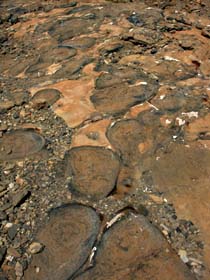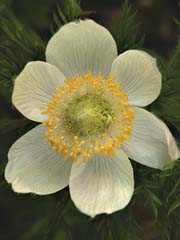Music • Photography • Writing
National Parks Of The American Rockies
Glacier
Page
1
Page
2
Page
3
Page
4
Page
5
Page
6

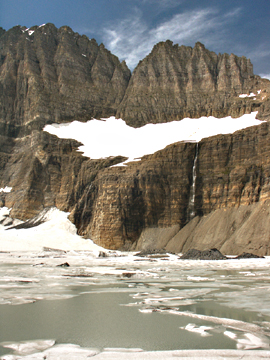
George Bird Grinnell was one of the first people to map some parts of what is now Glacier National Park, including this area where Salamander Glacier still clings to the sheer cliffs of the Garden Wall above Ice Lake. (The Garden Wall is just as steep on the other side.) Grinnell was a pioneer of the conservation movement. Schooled literally by John James Audubon, he had an early interest in his (middle) namesake. A friend of Theodore Roosevelt, Grinnell was instrumental in establishing Glacier National Park, as well as founding the first Audubon Society, dedicated to preserving not only birds, but all wild creatures. Note the piles of rock and gravel at left brought down by last winter's snow.
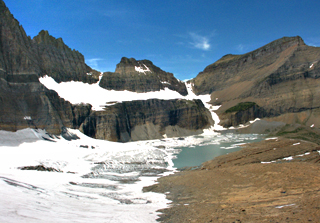
For those who think that global warming is just something cooked up by tree-huggers, I've provided this picture of the cirque from above. In the foreground is Grinnell Glacier, with Salamander Glacier and Ice Lake beyond. When Grinnell came here in the 1890s, the two glaciers were connected and ice covered the whole lake. For perspective, the black band of diorite in the Garden Wall at left is about 250 feet thick.
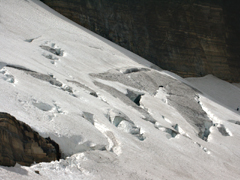
Glacier National Park is named for the effects of the glaciers in the past, which is profound. Before the ice got to them, these mountains were taller than the present-day Himilayas, but today there are only five peaks in the park over 10,000 feet. But the glaciers that remain are still potent. At left is a picture of some of the large (10- to 15-feet wide) crevasses on Grinnell Glacier, which are very hazardous.
The mountains of the park are composed mostly of sedimentary rocks formed in an ancient seabed nearly a billion years ago. At that time, there was virtually no oxygen in Earth's atmosphere and the dominant life forms were tiny cyanobacteria. (For more about bacteria, see Bacteria Art.) Still found, largely unchanged, on the coast of Australia, these primitive creatures build stromatolites, mounds of mineral deposits, which form the round blobs, a foot or two across, that you see here. (These have been squished by eons of intense pressure from overlying rock. To see what they look like when a glacier scrapes them off, double click the picture. Single click to restore the original image.)
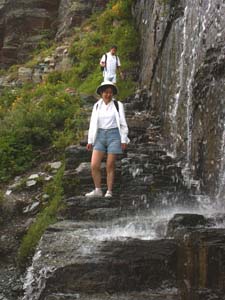
The trail to Ice Lake and Grinnell Glacier is a popular one, partly because it follows the south-facing slope and melts off early in the spring. But that slope, with breathtaking views but few trees, is sunny and hot in the summer. So most hikers relish this spot, where the trail follows a ledge of rock through a little waterfall, which, ice cold, feels quite refreshing. A few years ago I saw, loping up the steep slope above the falls, the one and only wolverine I've ever seen in the wild. Relatives of badgers, wolverines are groud-hugging, dark brown hunters, the most dangerous mammals, for their size, in North America. Don't mess with 'em
Summer in Glacier is just a few weeks wedged between spring and fall, so flowers can bloom most anytime. This globe flower is usually associated with spring, but where the snow lays heavy and long, it often doesn't send up this pretty white flower until July. And within a few days, the petals and yellow anthers fall off and the seed head in the center grows and expands. To see the result, double click the image. (Single click to return.) A similar species in the Northwest is known as the Tow-Headed Baby.

